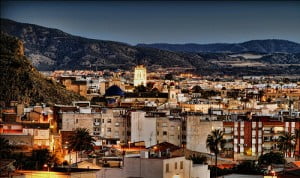
First of all, Orihuela is a beautiful city.
More specifically, the wonderful charm and character of the old Spanish town.
Under the foot of a hill.
As a matter of fact, Orihuela city is a large town covering an area of nearly 400 km2.
Vega Baja
Not only Orihuela is the historical capital of the Vega Baja, but also the Veja Baja is the most south situated region of the Alicante province.
In addition Vega Baja is the land of monuments, salt lakes and orchards.
In this region you can discover fine sandy beaches. They are starting from Guardamar del Segura to Pilar de la Horadada.
There are three salt lakes to discover in this region. The salt lakes are Santa Pola and the salt lakes of Torrevieja : La Mata and Torrevieja Natural park.
The region of Orihuela can devised into three districts. As a matter of fact these districts are: the coastal area also known as the Orihuela Costa. Than the city itself and then the surrounding countryside.
And at the countryside you can explore the “Pedrera” Reservoir.
Orihuela city.
As the city of Orihuela is full of museums and religions buildings, it is worth a visit.
In addition ,the town center is declared a historic and Artistic Monumental due to its rich heritage.
Also in the historical center you can find the tourist information office.
Make a visit to the office. Of course, they inform you with a map and the correct list of the prices and opening times.
In addition, the opening hours and days of the museums are changing in Spain. This depend on the summer or winter season.
Even when you are not a “cultural” lover, Orihuela is worth a visit.
First, take a walk beside the Rio Segura which runs trough the city. Then you can discover the many nice shops and try the tapas bars.
Furthermore there are also little restaurants with their delicious local day menu.
To say nothing , of the beautiful plaza’s. They are the places to sit and watch the world go by.
Besides, in Orihuela city their is a nice local market on Tuesday and another at Friday morning.
Discover and shop at the Ociapia Mall at Orihuela .
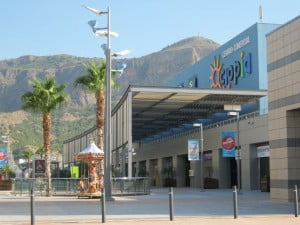
Palmeral Park at Orihuela.
The most popular park of the Costa Blanca is the Palmeral park of Elche. As a matter of fact , Orihuela has the second largest palmeral in Spain even of Europe.
In the south of Spain, a Palmeral is a style of farming since the Moorish occupation.
In the past, they planted the palm trees between the different plots.
Now, this tradition survived the centuries because it is practical.
Coupled that the Palm Park is located on the borders of the historical center of Orihuela.
Below, at the foot of the Sierra Orihuela the palm park starts . And then continues to the the mainlands.
In this way the” Palmeral Park” makes a green connection. and this between the dry land, where palm trees flourish and the irrigable land.
Again, the land is crossed by the Rio Segura and lots of canals. Sure a nice view.
As a matter of fact, the palm tree is very popular in Spain. But also in West European, there are an ideal southern garden decoration.
Equally important,the Palm park of Orihuela was declared a Cultural Historic Heritage.
Natural Park Pinar de Bonanza.
Nearby Orihuela city there is a nice natural park.
In the first place, the park is popular for walking, cycling or hiking with nice picnic places.
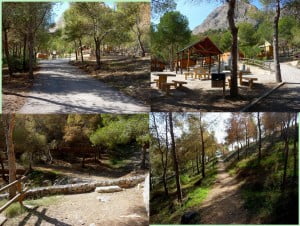
Train station.
In addition, Orihuela city got a modern train station just 1 km from the city center.
As a result, that the city is connected by train to the nearby Alicante, Elche or Murcia.
Furthermore , the station is on the main line from North to South.
This line is used by different regional operates.
More information can be found on the website of the trains in Spain RENFE.
There are also slower local trains, the “cercanias” in Spanish.
Of course you can visit the Vega Baja region city’s. To sum up : Torrevieja. Orihuela. Pilar de Hordada. Rojales. Almoradi. Callosa de Segura. Guardamar del Segura and Albatera.
But also San Fulgencio. Catral. San Miguel de Salinas. Redovan. Dolores. Bigastro. Cox. Benjuzar. Los Montesinos. Rafal. Benijofar. Algorfa and Formentera del Segura.
And furthermore also Granja de Rocamora. Jacarlilla.Daya Nueva. Benfirri. San Isidro and Daya Vieja.
For the Cultural lovers: Orihuela museums.
Miguel Hernandez House Museum.
Nearby the Santa Domingo Diocese College is the Miguel Hernandez House Museum.
In the past, this building was the house and home to the poet Miguel Hernandez.
Miguel Hernandez was born in Orihuela with poor parents. His father was a herdsman and dealer in sheep’s . He took for granted that his son would soon be a hard worker. From a very young age Miguel Hernandez was expected to work in the stables.
This solitary working had a profound influence on him. And his work on the farm and in the nature led him to a special bond with the nature.
This passion reflects in his poetry.
Against all odds, he broke loose of his humble roots. And so he became one of the greatest and best know Spanish poets.
Santa Domingo Diocese College.
In the past, this college was a University from 16th century till the 19th century.
And in 1998 it became a part the University of the Alicante.
Then the college itself underwent changes in the first half of the 18th century.
Also the Santa Domingo Diocese College represents a good mix of styles. And that between the Renaissance and the the Baroque styles.
Cloisters
Inside the large building there are two impression cloisters. The Renaissance cloisters in the convent and the University cloister. This last is a example of the later additions of the Baroque.
On the exterior, there are two renaissance doorways featuring the founders. More specifically , Fernando de Loazes his family coat and arms.
And on the doorway the shield of the Dominican Order is featured.
Not only the entrance to the University is typical Baroque, but shows also an figure representing wisdom.
The Renaissance doorway leading to the Sacristy is dating back from the 16th century. The doorway got a Valencian tiling from the 18th century.
Salvador and Santa Maria Cathedral.
In the past, once again in this region an cathedral was built on the remains of an old Moorish mosque.
It started as a church, ascending in importance , than became a Collegiate. And at last a Cathedral in 1510.
The building of the church started at the 13th century and was Catalan Gothic style.
The three main gateways shows the influences of the Gothic and the Renaissance style.
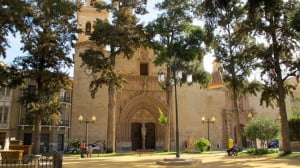
Episcopal Palace of Orihuela.
First, the Episcopal Palace is one of Orihuela’s medieval hospitals.
The building of the hospitals started in the 16th Century. Now, it is the city’s largest palace.
and it is built in a rectangular form with three patios.
The Town Wall Museum.
In the first place, the remains of the heritage of Orihuela is well conserved in this museum.
Not only the town wall itself, but also the four watch towers. And the remains of the Arabians baths.
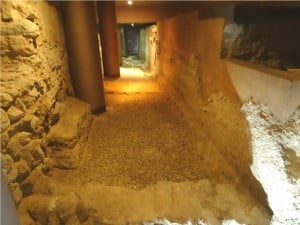
The Paris Church of Saints Justa and Rufina.
Again, the Paris Church was built on the remains of one of the Islamic mosques.
More specific, Saints Justa and Santa Rufina were the two patrons of the city of Orihuela.
So, it is dedicated to the two sisters.
and the church was built in the Catalan Gothic style in the 14th century.
The Salesian Monastery of Orihuela.
In the past, the Salesian Monastery was built on the remains of a Jesuit College .
Indeed, the Royal Monastery was built in neo-classical style.
The outside facade is made from Spanish red and black marble.
Inside there is a interesting collection of painting by the court painter. His name was Vicente Lopez and he was a member of the Valencian school.
San Juan de Dios , Local Archaeological Museum.
First of all, the Museum shows remains from the Paleolithic to the early 19th century.
The materials were discovered in the town of Orihuela and its surroundings.
Santiago Parish Church.
Once again, built in the 15th century on the remains of a Islamic mosque.
Our Lady of Montserrate.
The most important, of our Lady of Montserrate is that it is a Baroque temple in the form of a cross.
And, the building has a neoclassic facade with the anagram of the virgin .